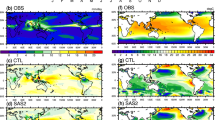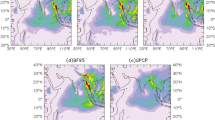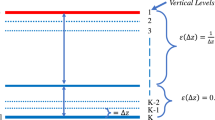Abstract
Recently, a high resolution atmospheric general circulation model, i.e., Global Forecast System has been operationalized for 10 days weather forecast over Indian region. However, for extreme weather systems such as cyclones, different physical processes and their interactions with atmosphere and ocean play an important role in cyclone intensity, track, etc. Keeping this in view, Coupled Forecast System model version 2 has been used to evaluate the simulation for three severe cyclones (Phailin, Viyaru and Lehar) of 2013. In the present study, along with already existing mass-flux cumulus parameterization, i.e., Simplified Arakawa–Schubert (SAS) and revised SAS (RSAS) parameterization schemes, an additional convective adjustment scheme, i.e., Betts–Miller–Janjic (BMJ) is implemented and its performance is evaluated for the Indian Ocean cyclones. The experiments are conducted with three cumulus schemes at three different resolutions (T126, T382, and T574). Both SAS and RSAS overestimate convective rain, whereas BMJ scheme produces convective rain comparable with the observation due to the fact that BMJ produces deeper convection and does not trigger the convection too often. BMJ sustains the instability and deep convection longer thereby impacting the cyclone intensity and heavy rainfall associated with it. It is also noted that BMJ is efficient in producing rain than the SAS and RSAS. From the analyses of OLR and rain rate, BMJ is found to simulate a much realistic relation of cloud and precipitation. The paper argues that compared to available SAS and RSAS, BMJ scheme realistically produces heavy precipitation associated with the tropical cyclone over Indian region in a coupled model.












Similar content being viewed by others
References
Abhik S, Mukhopadhyay P, Krishna R P M, Salunke K, Dhakate A R and Rao A S 2016 Diagnosis of boreal summer intraseasonal oscillation in high resolution NCEP climate forecast system; Clim. Dyn. 46 3287–3303.
Abhik S, Krishna R P M, Mahakur M, Ganai M, Mukhopadhyay P and Dhudhia J 2017 Revised cloud processes to improve the mean and Intraseasonal variability of Indian summer monsoon in climate forecast system: Part 1; J. Adv. Model Earth Syst. 9 1002–1029, https://doi.org/10.1002/2016ms000819.
Abhilash S, Sahai A K, Pattanaik S, Goswami B N and Arun K 2013 Extended range prediction of active-break spells of Indian summer monsoon rainfall using an ensemble prediction system in NCEP climate forecast system; Int. J. Climatol. 34 98–113.
Arakawa A 2004 The cumulus parameterization problem: Past, present and future; J. Climate 17 2493–2525.
Arakawa A and Schubert W H 1974 Interaction of a cumulus cloud ensemble with the large-scale environment. Part I; J. Atmos. Sci. 31 674–701.
Arakawa A, Jung J-H and Wu C-M 2011 Towards unification of the multiscale modelling of the atmosphere; Atmos. Chem. Phys. 11 3731–3742.
Betts A K and Miller M J 1986 A new convective adjustment scheme Part II: Single column tests using GATE wave, BOMEX, and arctic air mass data sets; Quart. J. Roy. Meteorol. Soc. 112 693–709.
Bombardi R J, Tawfik A B, Manganello J V, Marx L, Shin C-S, Halder S, Schneider E K, Dirmeyer E K and Kinter III J L 2016 The heated condensation framework as a convective trigger in the NCEP Climate Forecast System version 2; J. Adv. Model. Earth Syst. 8 1310–1329.
Bombardi R J, Schneider E K, Marx L, Halder S, Singh B, Tawfik A B, Dirmeyer P A and Kinter III J L 2015 Improvements in the representation of the Indian summer monsoon in the NCEP: The heated condensation framework as a convective trigger in the NCEP Climate Forecast System version 2; Clim. Dyn. 45 2485–2498.
Clough S A, Shephard M W, Mlawer E J, Delamere J S, Iacono M J, Cady-Pereira K, Boukabara S and Brown P D 2005 Atmospheric radiative transfer modeling: A summary of the AER codes; J. Quant. Spectrosc. Radiat. Transfer 91 233–244.
Deshpande M S, Pattanaik S and Salvekar P S 2012 Impact of cloud parameterization on the numerical simulation of a super cyclone; Ann. Geophys. 30 775–795.
Ek M B, Mitchell K E, Lin Y, Rogers E, Grunmann P, Koren V, Gayno G and Tarplay J D 2003 Implementation of Noah land surface model advances in the National Centers for Environmental Prediction operational mesoscale Eta model; J. Geophys. Res. 108(D22) 8851.
Eitzen Z A and Randall D A 1999 Sensitivity of the simulated Asian summer monsoon to parameterized physical processes; J. Geophys. Res. 104(D10) 12,177–12,191.
Ganai M, Krishna R P M, Tirkey S, Mukhopadhyay P, Mahakur M and Han J-Y 2019 The impact of modified fractional cloud condensate to precipitation conversion parameter in revised simplified Arakawa–Schubert convection parameterization scheme on the simulation of Indian summer monsoon and its forecast application on an extreme rainfall event over Mumbai; J. Geophys. Res.: Atmos. 124, https://doi.org/10.1029/2019JD030278.
Ganai M, Mukhopadhyay P, Krishna R P M and Mahakur M 2015 The impact of revised simplified Arakawa–Schubert convection parameterization scheme in CFSv2 on the simulation of the Indian summer monsoon; Clim. Dyn. 45 881–902.
Ganai M, Mukhopadhyay P, Krishna R P M and Mahakur M 2016 The impact of revised simplified Arakawa–Schubert scheme on the simulation of mean and diurnal variability associated with the active and break phases of Indian summer monsoon using CFSv2; J. Geophys. Res. Atmos. 121 9301–9323, https://doi.org/10.1002/2016jd025393.
Goswami B B, Deshpande M S, Mukhopadhyay P, Saha S K, Rao A S, Murthugudde R and Goswami B N 2015 Simulation of monsoon intraseasonal variability in NCEP CFSv2 and its role on systematic bias; Clim. Dyn. 28 8988–9012.
Goswami P, Mandal A, Upadhyaya H and Hourdin F 2006 Advance forecasting of cyclone track over North Indian Ocean using a global circulation model; Mausam 57 111–118.
Goswami P, Mallick S and Gouda K C 2011 Objective debiasing for improved forecasting of tropical cyclone intensity with a Global Circulation model; Mon. Wea. Rev. 139 2471–2487.
Griffies S M, Harrison M J, Pacanowsk, R C and Rosati A 2004 A technical guide to MOM4; GFDL ocean group technical report 5 GFDL, 337p.
Han J and Pan H L 2011 Revision of convection and vertical diffusion schemes in the NCEP Global Forecast System; Wea. Forecasting 26 520–533.
Hong D Y and Dudhia J 2012 Next-generation numerical weather prediction: Bridging parameterization, explicit clouds and large eddies; Bull. Am. Meteorol. Soc. 93 (Suppl.), https://doi.org/10.1175/2011bams3224.1.
Hong S Y and Pan H L 1998 Convective trigger function for a mass flux cumulus parameterization scheme; Mon. Wea. Rev. 126 2599–2620.
Iacono M J, Mlawer E J, Clough S A and Morcrette J-J 2000 Impact of an improved longwave radiation model, RRTM, on the energy budget and thermodynamic properties of the NCAR Community Climate Model, CCM3; J. Geophys. Res. 105 14873–14890.
Iguchi T, Kozu T, Meneghine R, Awaka J and Okamoto K 2000 Rain-profiling algorithm for the TRMM precipitation radar; J. Appl. Meteor. 39 2038–2052.
Janjic Z I 1994 The step-mountain eta coordinate model: Further developments of the convection, viscous sublayer, and turbulence closure schemes; Mon. Wea. Rev. 122 927–945.
Janjic Z I 2000 Comments on ‘Development and evaluation of a convection scheme for use in climate models’; J. Atmos. Sci. 57 3686.
Kanase R D and Salvekar P S 2015a Impact of physical parameterization schemes on track and intensity of severe cyclonic storms in Bay of Bengal; Meteorol. Atmos. Phys. 127 537–559.
Kanase R D and Salvekar P S 2015b Effect of Physical parameterization schemes on track and intensity of cyclone LAILA using WRF model; Asia-Pac. J. Atmos. Sci. 51 205–227.
Kanase R D, Mukhopadhyay P and Salvekar P S 2015 Understanding the role of cloud and convective processes in simulating the weaker tropical cyclones over Indian Seas; Pure Appl. Geophys. 172 1751–1779.
Krishnamurti T N 2005 Weather and seasonal climate prediction of Asian summer monsoon, The Global Monsoon System: Research and Forecast; WMO/TD No. 1266 342–375.
Krishnamurti T, Oosterhof D and Dignon N 1989 Hurricane prediction with a high resolution global model; Mon. Wea. Rev. 117 631–669.
Li F, Rosa D, Collins W D and Wehner M F 2012 Super-parameterization: A better way to simulate regional extreme precipitation?; J. Adv. Model Earth Syst. 4 M04002, https://doi.org/10.1029/2011ms000106.
Lim S K-S, Hong S-Y, Yoon J-H and Han J 2014 Simulation of the summer monsoon rainfall over East Asia during the NCEP GFS cumulus parameterization at different horizontal resolutions; Wea. Forecasting 29 1143–1154.
Ma L M and Tan Z M 2009 Improving the behavior of the cumulus parameterization for tropical cyclone prediction: Convection trigger; Atmos. Res. 92(2) 190–211, https://doi.org/10.1016/j.atmosres.2008.09.022.
Mahakur M, Prabhu A, Sharma A K, Rao V R, Senroy S, Singh R and Goswami B N 2013 A high-resolution outgoing longwave radiation dataset from Kalpana-1 satellite during 2004–2012; Curr. Sci. 105(8) 1124–1133.
Manabe S, Smagorinsky J and Strickler R F 1965 Simulated climatology of a general circulation Model with a hydrologic cycle; Mon. Wea. Rev. 93(12) 769–798.
Mohapatra M, Nayak D P, Sharma R P and Bandyopadhyay B K 2013 Evaluation of official tropical cyclone track forecast over north Indian Ocean issued by India Meteorological Department; J. Earth Syst. Sci. 122(3) 589–601.
Mukhopadhyay P, Taraphadar S, Goswami B N and Krishnakumar K 2010 Indian summer monsoon precipitation climatology in a high-resolution regional climate model: Impacts of convective parameterization on systematic biases; Wea. Forecasting 25 360–387.
Mukhopadhyay P, Taraphdar S and Goswami B N 2011 Influence of moist processes on track and intensity forecast of cyclones over the north Indian Ocean; J. Geophys. Res. 116(D05116) 1–21, https://doi.org/10.1029/2010JD014700.
Mukhopadhyay P et al. 2019 Performance of a very high-resolution global forecast syetm model (GFS T1534) at 125 km over the Indian region during the 2016–2017 monsoon seasons; J. Earth Syst. Sci. 128 155, https://doi.org/10.1007/s12040-019-1186-6.
Osuri K K, Mohanty U C, Routray A, Mohapatra M and Nivogi D 2013 A real-time track prediction of tropical cyclones over the north Indian Ocean using the ARW model; J. Appl. Meteorol. Climatol. 52 2476–2492.
Palmer T N and Anderson D L T 1994 The prospects of seasonal forecasting – a review paper; Quart. J. Roy. Meteor. Soc. 120 755–793.
Pattanaik S, Abhilash S, De S, Sahai A K, Phani R and Goswami B N 2013 Influence of convective parameterization on the systematic error of Climate Forecast System (CFS) model over the Indian monsoon region from an extended range forecast perspective; Clim. Dyn. 41 341–365.
Ramu D A, Sabeerali C T, Chattopadhyay R, Nagarjuna R D, George G, Dhakate A R, Salunke K, Srivastava A and Suryachandra A R 2016 Indian summer monsoon rainfall simulation and prediction skill in the CFSv2 coupled model: Impact of atmospheric horizontal resolution; J. Geophys. Res. Atmos. 121 2205–2221.
Rao Suryachandra A, Goswami B N, Sahai A K, Rajagopal E N, Mukhopadhyay P, Rajeevan M, Nayak S, Rathore L S, Shenoi S S C, Ramesh K J, Nanjundiah R, Ravichandran M, Mitra A K, Pai D S, Bhowmik S K R, Hazra A, Mahapatra S, Saha S K, Chaudhari H S, Joseph S, Pentakota S, Pokhrel S, Pillai P A, Chattopadhyay R, Deshpande M, Krishna R P M, Siddharth Renu, Prasad V S, Abhilash S, Panickal S, Krishnan R, Kumar S, Ramu D A, Reddy S S, Arora A, Goswami T, Rai A, Srivastava A, Pradhan M, Tirkey S, Ganai M, Mandal R, Dey A, Sarkar S, Malviya S, Dhakate A, Salunke K and Maini Parvinder 2020 Monsoon mission: A targeted activity to improve monsoon prediction across scales; Bull. Am. Meteorol. Soc. 100 2509–2532, https://doi.org/10.1175/BAMS-D-17-0330.1.
Rauscher S A, Seth A, Qian J-H and Camargo S J 2006 Domain choice in an experimental nested modelling prediction system for South America; Theor. Appl. Climatol. 86 229–246.
RSMC Report 2014 A report on cyclonic disturbances over North Indian Ocean during 2013; India Meteorological Department, New Delhi, India.
Saha S et al. 2006 The NCEP climate forecast system; J. Clim. 15 3483–3517.
Saha S et al. 2010 The NCEP climate forecast system reanalysis. Bull. Am. Meteorol. Soc. 91 1015–1057.
Saha S et al. 2014 The NCEP climate forecast system version 2; J. Climate 27 2185–2208.
Sahai A K, Abhilash S, Chattopadhyay R, Borah N, Joseph S, Sharmila S and Rajeevan M 2014 High-resolution operational monsoon forecasts: An objective assessment; Clim. Dyn. 44 3129–3140.
Saji M and Ashrit R 2014 Sensitivity of different convective parameterization schemes on tropical cyclone prediction using a mesoscale model; Nat. Hazards 73 213–235, https://doi.org/10.1007/s11069-013-0824-6.
Slingo J M, Mohanty U C, Tiedtke M and Pearce R P 1988 Prediction of the 1979 summer monsoon onset with modified parameterization schemes; Mon. Wea. Rev. 116 328–346.
Slingo J M et al. 1996 Intraseasonal oscillations in 15 atmospheric general circulation models: Results from an AMIP diagnostic subproject; Clim. Dyn. 12 325–357.
Strachan J, Vidale P L, Hodges K, Roberts M and Demory M-E 2013 investigating global tropical cyclone activity with a hierarchy of AGCMs: The role of model resolution; J. Clim. 26 133–152, https://doi.org/10.1175/jcli-d-12-00012.1.
Sun Y, Zhong Z, Dong H, Shi J and Hu Y 2015 Sensitivity of tropical cyclone track simulation over the western north pacific to different heating/drying rates in the Betts–Miller–Janjic scheme; Mon. Wea. Rev. 143 3478–3494.
Tiedtke M 1989 A comprehensive mass flux scheme for cumulus parametrization in large-scale models; Mon. Wea. Rev. 117 1799–1800.
Tirkey S, Mukhopadhyay P, Krishna R P M, Dhakate A and Salunke K 2019 Simulations of monsoon intraseasonal oscillation using climate forecast system Version 2: Insight for horizontal resolution and moist processes parameterization; Atmosphere 10 429; https://doi.org/10.3390/atmos10080429.
Vaidya S S 2006 The performance of two convective parameterization schemes in a mesoscale model over the Indian region; Meteorol. Atmos. Phys. 92 175–190.
Vaidya S S and Singh S S 1997 Thermodynamic adjustment parameters in the Betts–Miller scheme of convection; Wea. Forecasting 12 819–825.
Vaidya S S and Singh S S 2000 Applying the Betts–Miller–Janjic scheme of convection in prediction of the Indian Monsoon; Wea. Forecasting 15 349–356.
Velden C S and Leslie L M 1991 The basic relationship between tropical cyclone intensity and the depth of the environmental steering layer in the Australian region; Wea. Forecasting 6 244–253.
Vitart F, Anderson J L, Sirutis J and Tuleya R E 2001 Sensitivity of tropical storms simulated by a general circulation model to changes in cumulus parameterization; Quart. J. Roy. Meteor. Soc. 127 25–51.
Winton M 2000 A reformulated three-layer sea ice model; J. Atmos. Ocean. Tech. 17 525–531.
Wu X, Simmonds I and Budd W F 1997 Modeling of Antarctic sea ice in a general circulation model; J. Clim. 10 593–609.
Wu W, Lynch W A and Rivers A 2005 Estimating the uncertainty in a regional climate model related to initial and lateral boundary conditions; J. Climate 18 917–933.
Yanai M, Esbensen S and Chu J-H 1973 Determination of bulk properties of tropical cloud clusters from large-scale heat and moisture budgets; J. Atmos. Sci. 30 611–627.
Yang S, Zhang Z, Kousky V E, Higgins R W, Yoo S-H, Liang J and Fan Y 2008 Simulations and seasonal prediction of the Asian Summer monsoon in the NCEP climate forecast system; J. Clim. 21 3755–3775.
Yang Y, Navon I M and Todling R 1999 Sensitivity to large-scale environmental fields of the relaxed Arakawa–schubert parameterization in the NASA GEOS-1 GCM; Mon. Wea. Rev. 127 2359–2378.
Zadra A R, McTaggart-Cowan R, Vaillancourt P A, Roch M, Belair S and Leduc A M 2014 Evaluation of tropical cyclones in the Canadian global modelling system: Sensitivity of moist process parameterization; Mon. Wea. Rev. 142 1197–1220.
Zhao Q and Carr F H 1997 A prognostic cloud scheme for operational NWP models; Mon. Wea. Rev. 125 1931–1953.
Acknowledgements
Authors gratefully acknowledge the comments of anonymous reviewers and editor which have helped to improve the paper. We thank Director IITM for all support to carry out this work. IITM is fully funded by Ministry of Earth Sciences, Government of India. We thank NCEP for providing the coupled model CFSv2 through monsoon mission. All datasets used for this study are freely available online. Tropical Rainfall Measurement Mission Project (TRMM) 3B42v7 and 3G68 rainfall data and ECMWF ERA interim as well as ERA5 dataset are acknowledged with thanks. The COLA’s GrADS free software and NCL software are extensively used in present study. The ‘Aaditya’ high power computer (HPC) facility and support are gratefully acknowledged.
Author information
Authors and Affiliations
Corresponding author
Additional information
Communicated by A K Sahai
Rights and permissions
About this article
Cite this article
Kanase, R.D., Deshpande, M.S., Krishna, R.P.M. et al. Evaluation of convective parameterization schemes in simulation of tropical cyclones by Climate Forecast System model: Version 2. J Earth Syst Sci 129, 168 (2020). https://doi.org/10.1007/s12040-020-01433-w
Received:
Revised:
Accepted:
Published:
DOI: https://doi.org/10.1007/s12040-020-01433-w




